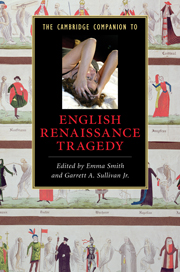Book contents
- Frontmatter
- Part 1 Themes
- 1 English Renaissance tragedy: theories and antecedents
- 2 Tragedy, family and household
- 3 Tragedy and the nation state
- 4 Tragedy and religion
- 5 Tragedy and revenge
- 6 Tragic subjectivities
- 7 Tragic forms
- 8 Tragedy and performance
- 9 Renaissance tragedy on film: defying mainstream Shakespeare
- 10 Shakespeare and early modern tragedy
- Part II Readings
- Index
5 - Tragedy and revenge
from Part 1 - Themes
Published online by Cambridge University Press: 28 November 2010
- Frontmatter
- Part 1 Themes
- 1 English Renaissance tragedy: theories and antecedents
- 2 Tragedy, family and household
- 3 Tragedy and the nation state
- 4 Tragedy and religion
- 5 Tragedy and revenge
- 6 Tragic subjectivities
- 7 Tragic forms
- 8 Tragedy and performance
- 9 Renaissance tragedy on film: defying mainstream Shakespeare
- 10 Shakespeare and early modern tragedy
- Part II Readings
- Index
Summary
Revenge has a good claim to being the dominant theme of English Renaissance tragedy. After the runaway success of Kyd's The Spanish Tragedy (c. 1587), stories of vengeance began to take over the English stage: as Fredson Bowers noted, dramatists learned from Kyd 'that there was no simpler method of motivating a conflict than by the revenge of a personal injury'. Although revenge came to play a role in many literary forms, it found its primary vehicle in tragedy, and especially in the particular genre we now refer to as revenge tragedy. Encompassing both the bloody sensationalism of plays such as Middleton's The Revenger's Tragedy (1606) and Webster's The Duchess of Malfi (1614), and the heart of the literary canon in Shakespeare's Hamlet (1599-1600), revenge tragedy was for a time the most popular form of English Renaissance tragedy, and arguably of the period's drama altogether.
Revenge tragedy is in some ways a surprising genre to become a popular bestseller. According to a longstanding literary hierarchy rooted in Aristotle and Horace, the 'higher and more loftie' genre of tragedy spoke to elite audiences, while lower forms such as comedy were 'the solace & recreation of the common people'. Revenge tragedy certainly had a lofty and learned cultural inheritance. Renaissance plays treating the topic of revenge drew on Latin plays by Seneca, as well as, less directly, the classical Greek plays that Seneca imitated and revised.
- Type
- Chapter
- Information
- The Cambridge Companion to English Renaissance Tragedy , pp. 58 - 72Publisher: Cambridge University PressPrint publication year: 2010
- 2
- Cited by

